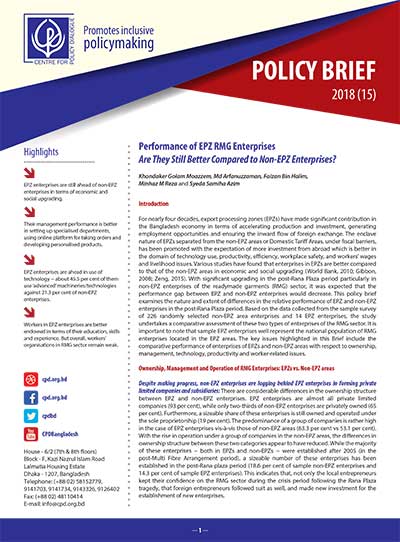
CPD Policy Brief 15
Performance of EPZ RMG Enterprises
Are They Still Better Compared to Non-EPZ Enterprises?
For nearly four decades, export processing zones (EPZs) have made significant contribution in the Bangladesh economy in terms of accelerating production and investment, generating employment opportunities and ensuring the inward flow of foreign exchange. The enclave nature of EPZs separated from the non-EPZ areas or Domestic Tariff Areas, under fiscal barriers, has been promoted with the expectation of more investment from abroad which is better in the domain of technology use, productivity, efficiency, workplace safety, and workers’ wages and livelihood issues. Various studies have found that enterprises in EPZs are better compared to that of the non-EPZ areas in economic and social upgrading (World Bank, 2010; Gibbon, 2008; Zeng, 2015). With significant upgrading in the post-Rana Plaza period particularly in non-EPZ enterprises of the readymade garments (RMG) sector, it was expected that the performance gap between EPZ and non-EPZ enterprises would decrease. This policy brief examines the nature and extent of differences in the relative performance of EPZ and non-EPZ enterprises in the post-Rana Plaza period. Based on the data collected from the sample survey of 226 randomly selected non-EPZ area enterprises and 14 EPZ enterprises, the study undertakes a comparative assessment of these two types of enterprises of the RMG sector. It is important to note that sample EPZ enterprises well represent the national population of RMG enterprises located in the EPZ areas. The key issues highlighted in this Brief include the comparative performance of enterprises of EPZs and non-EPZ areas with respect to ownership, management, technology, productivity and worker-related issues.
Authors: Khondaker Golam Moazzem, Md Arfanuzzaman, Faizan Bin Halim, Minhaz M Reza and Syeda Samiha Azim
Publication period: August 2018
Download


